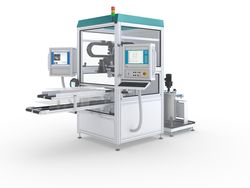Very often, automation becomes expensive and therefore inefficient due to the requirement of a very precise feed of parts. In order to avoid expensive intermediate steps in the production chain, Sonderhoff has taught its mixing and dosing systems to see. The great advantage of the automatic parts recognition is that customers can save on investment costs for the component holding fixture on the mixing and dosing system and save themselves long installation times. Components with the most diverse shapes and sizes can be put on the transfer conveyor and transferred to the mixing head of the dispensing cell in any order without being positioned exactly. Due to the image recognition system of the dispensing cell SMART, the fully automatic manufacturing process for sealing components with Sonderhoff foam seal or potting material is also possible in the case of a chaotic parts feed.
With high-performance optics, permanently installed in the dispensing cell, the intelligent image recognition system verifies the arbitrary position of the components on the transfer conveyor and automatically recognizes the different component sizes and shapes. In order to capture the image data, the conveyor belt stops for a short period of time and sends the component-specific image data to the 3-axis linear robot control. The dosing contour program for the different component shapes to be processed is adjusted accordingly and the contouring control of the 3-axis linear robot is corrected in such a way that the foaming or potting is always carried out precisely at the right place on the component. The image processing software can be programmed to automatically reject defective parts.
The Sonderhoff 3-axis linear robot can scan components with a traversing range of up to 500 x 500 mm (width x depth) and up to a parts height of 200 mm at the most. In doing so, the mixing head of the SMART dispensing cell is positioned with a repeat accuracy of +/- 0.05 mm above the component so that the sealing material can be precisely applied directly onto the component or in a groove by the mixing head dosing nozzle. A maximum acceleration of 5 m/s² in component radii is possible with the Sonderhoff linear robot.
The material used for a polyurethane- or silicone-based foam gasket or potting from the Sonderhoff Chemicals product range is processed by the dispensing cell SMART with a consistently high production quality, with a stable material consistency and constant seal dimensions. The dispensing cell SMART - DM 402 can be equipped with the mixing heads MK 600, MK 625 or MK 650 for micro-seals (up to 2 mm). The discharge performance of the mixing head is between 0.05 and 100.0g/s. The system can process viscosities of the sealing material between 300 and 2 million mPas without problems and the mixing ratio can be set continuously from 100:1 to 1:100.
Due to its compact design and small size, the dispensing cell SMART - DM 402 can be easily integrated into existing production concepts. With overall dimension of 1200 x 1200 x 2300 mm (width x depth x height) only minimal space is required. This mixing and dosing cell from Sonderhoff should be interesting in particular for customers from the electronics, telecommunications and IT industry as well as for medical devices manufacturers who need to seal especially small components and system components. In the model of the dispensing cell SMART, equipped with the mixing head MK 650, very small foam gaskets, so-called micro-seals, can be applied with a discharge performance of up to 0.1 g/s. In the case of the potting of electronics components micro-potting with a discharge amount even as low as 0.05 g/s can be realized.
For many plastics processing companies, production orders with small batch sizes but a high variety of components become more and more of a challenge. In this case, fully automatic manufacturing processes often make no sense as the constant change of materials and the frequent replacement and installation of the parts holding fixtures lead to high machine set-up times which increase the costs per unit. Companies have to react to this in a flexible way in order to remain competitive. However, a high variety and constantly changing component sizes are no problem for the dispensing cell SMART - DM 402 with its optical component recognition, the system rather achieves much shorter machine set-up times and thus decreasing costs per unit.
As last year at Fakuma, Sonderhoff can be found on two fair stands in 2012, with its own booth in hall A5 and as ENGEL system partner at the booth of ENGEL AUSTRIA, the renowned manufacturer of injection moulding machines from Schwertberg/Austria in the same hall. Sonderhoff presents there the MOLD’n SEAL procedures, a system solution for intelligent process integration interlinking the ENGEL machine victory 1350/300 tech and the dispensing machine DM 402 from Sonderhoff Engineering.
MOLD’n SEAL combines two formerly separated processes injection moulding and foam gasket application from the viewpoint of high efficiency and product quality in one production step.
The complete production cell including mixing and dosing system, handling robot and transfer conveyor belt requires only a footprint of 24 square metres. In this cell the fair visitors will see the injection moulding production of housings for moisture-proof lamps, immediately followed by foam gasket application with sealant based on polypropylene from Sonderhoff Chemicals in the groove of the component which is only few millimetres wide. This application of extremely accurate contour sealing in the very narrow component groove is only possible in the first place through the high movement constancy and repeat accuracy of the ENGEL easix 6-axis robot and the precise mixing and dosing technology from Sonderhoff Engineering.
Sonderhoff at the Fakuma 2012 can be found at its own booth 5109 in hall A5 and as system partner of ENGEL Austria on their stand 5204, hall A5.

